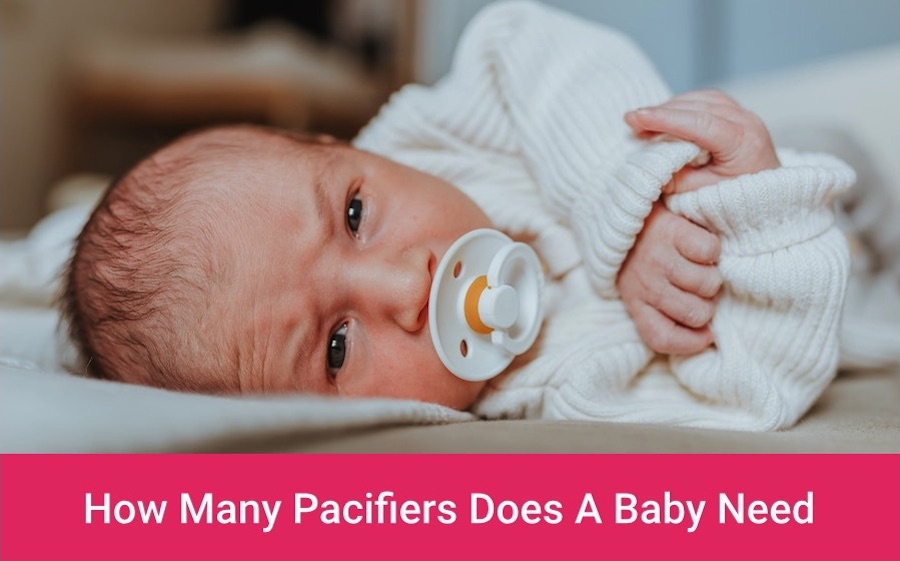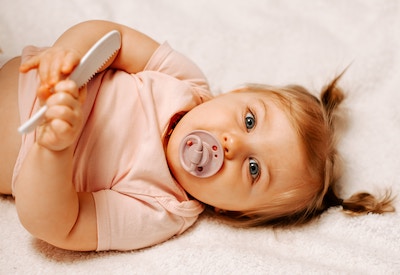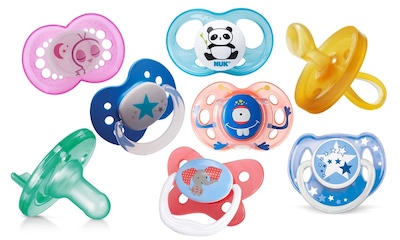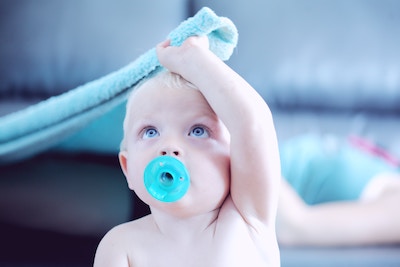
Article By Edna Skopljak – Medical Doctor (MD)
I believe everybody in the world well knows that a pacifier use soothe babies and may calm your crying newborn baby in a minute. And, most parents find this very helpful.
So, it’s not weird that a pacifier (usually more pacifiers) is situated very high on the registry list when you’re expecting a baby.
However, some parents-to-be and new parents are worried about the disadvantages of the pacifier and may wonder if they should buy it at all.
Hearing all that advice can be so overwhelming and stressful (usually without any need for stress), especially for first-time parents. Despite all, most babies still get at least one pacifier. And – it usually doesn’t end up there.
If you are one of those parents who are preparing your registry list, and considering buying baby’s pacifier, you may be wondering how many pacifiers you should get for your little one.
How many pacifiers are enough? How many pacifier clips? How many pacifier holders? How often do you need to change the pacifier? You may have tons of questions, and it’s completely normal.
If you want to find out more about pacifier use, stay tuned, as this article will guide you through the process of choosing the right pacifier for your baby and safe pacifier usage.
This article is not a substitute for medical advice or consultation.
Is Pacifier Really A Must-Have For My Baby?
Pacifier is not REALLY a must-have. However, it has so many advantages that may surely ease your new-parenting journey. And you will want to try everything that could comfort your fussy baby – or that will provide you a small break when you get so exhausted and cry for rest.

How Many Pacifiers Do I Need?
Although there are no some set or strict rules on how many pacifiers do you need for your baby, this number depends on several factors: how long will you use a pacifier, baby’s age, baby’s preferences, and so on.
The pacifier amount depends on the baby’s age. Plus, a baby’s mouth grows as the baby grows, so you will need to upgrade the size, too. And, it’s essential to buy your baby the right sized pacifier. So, let’s see how many pacifiers you need according to baby’s age:
- 0-6 Months
Although you may need only two to three pacifiers, it is better to get a few more. In this period, you will need pacifiers most, so it would be wise to get a few spare pacifiers for your baby – in each area, you might need it. Also, having a few different types of pacifiers would be a good idea, because not all babies prefer the same pacifier. So, for the beginning, make sure you have one pacifier of each type. You will soon find which pacifier your baby prefers.
It’s very important to find the right type and size of the pacifier to prevent baby from gagging on it.
- 6-12 Months
Once you get to know your baby’s preferences and your baby has its own favorite pacifier, stock up with at least two pacifiers. One for regular use, and one as a spare. If your baby visits daycare, it would be good to have one just for that purpose.
- 12+ Months
Again, two pacifiers seem reasonable. It’s generally advisable to start reduce using a pacifier during this period. Your baby will probably start weaning once they turn approximately two years of age. Until this age, have one to two pacifiers after your baby’s first birthday.
At this point you can also start to introduce one of the pacifier alternatives to make it easier for your little one to say goodbye to their favorite binky.

How Many Pacifiers Do I Need For A Newborn?
Newborn needs are different from the needs which older infants may have. In these first days, everything may be just too stressful. You are still in the process of getting to know your baby. And your baby still has to decide what they prefer.
So, for newborns, it would be a good idea to get one pacifier from several different types, to see which pacifier the baby prefers – if they will like it at all. Then, when they let you know which pacifier works for them, stock up on that particular pacifier.
Make sure you get at least two to three pacifiers for them. Extra pacifiers are always a good idea. And yes, always keep one spare pacifier in a diaper bag.
| PRO TIP: Are you wondering if you should also get a few pacifier clips? Are they really necessary? And most importantly, are they safe for infants? Read our tips for deciding how many pacifier clips to buy & how to choose the safest ones. |
How Long Can A Baby Use 1 Pacifier?
Due to the build-up of germs and bacteria and the natural wear and tear of the product, pacifiers should be replaced at least every two to four weeks. This, however, depends on how often and how much your baby actually uses a pacifier.
After your little one turns 6 months old, you should replace all of your baby’s pacifiers with ones sized for babies 6 months and older. The same goes when your baby turns one year.
Can You Have Too Many Pacifiers?
The truth is – you can’t have too many pacifiers (as long as that’s a reasonable number). The baby may lose their pacifier (a lost pacifier may bring a lot of crying), or the pacifier may fall down, get dirty, or they may stop enjoying that particular pacifier.
Plus, you need to change pacifiers from time to time. So, you don’t want to be stuck without it. It is a smart idea to have an extra pacifier in your diaper bag, too.
On the other hand, you may also solve those problems by using pacifier clips. Pacifier clips are also very convenient.
How Much Is Too Many Pacifiers?
As previously said, you can’t actually have too many pacifiers. However, there is no need for twenty different pacifiers, for sure. How many pacifiers you buy depends on your wishes, but be reasonable in pacifier shopping.

What Age Should My Baby Stop Using Pacifier?
Pacifiers are a great tool to soothe your (newborn) baby… up to a certain degree. Although beneficial at first, pacifiers can bring more risks once your baby gets older. In this article you can find our tips for getting baby to sleep without their favorite binky and weaning off pacifier.
Most babies stop using a pacifier on their own somewhere between 2 and 4 years of age1, other babies need help breaking the habit of using pacifiers.
Generally, it is advised that you start weaning your baby off their pacifier by the age of six months to around 18 months2. And, this habit should be completely discontinued by the age of 4 years, to avoid dental issues. Prolonged use may do more harm than good!
Benefits Of Pacifiers
Surely, pacifiers have their benefits. And for some babies, that is a key to contentment and calmness. Here are some benefits if you use a pacifier for your baby3:
-
Pacifiers May Soothe Your Fussy Baby
Babies have strong suckling reflex, and it’s something that calms them down. Most babies are content when they’re sucking on something. That is especially true for breastfed babies. However, moms can’t breastfeed all the time. This is where the pacifier jumps in (but wait the first few weeks, read on to find out why).
-
Pacifiers Might Help Your Baby Fall Asleep
If your baby has trouble settling down, or you have issues with baby sleep and their nap time, a pacifier might do the trick. As is written above, many babies are soothed by suckling – and a pacifier. So, it may be a great way to help them sleep (yes, even during the nighttime).
-
Pacifiers Offer Temporary Distraction
A pacifier may be really helpful during and after shots, blood tests, or other procedures, but also travel, flights, and so on. Plus, if you use a pacifier on a flight, it may ease discomfort during flights, as sucking on a pacifier may “pop” a baby’s ears to relieve ear pain caused by air pressure changes.
-
Pacifiers May Help Reduce The Risk Of Sudden Infant Death Syndrome (SIDS)
Sucking on a pacifier during naps and bedtime may help you reduce the risk of sudden infant death syndrome in your baby. And that is scientifically proven!
-
It’s Easier To Break A Habit For Pacifiers Than Thumbs
Babies love suckling. Sometimes, when you don’t give them a pacifier, they start sucking their fingers or thumbs. This habit is more difficult to break than a pacifier.
-
It’s Great For Teething
Pacifier is a great teething toy once you get to this point. When your baby starts to drool and becomes more fussy than usual (somewhere around six months), a pacifier will be your friend.

Risks Of Using Pacifier
Although there are many benefits to using a pacifier, there are certain risks and drawbacks as well4. And, those are the following:
-
Your Baby Might Become Dependent On The Pacifiers
If your little one needs it to sleep, you may face difficulties and nighttime crying when the pacifier falls out of your baby’s mouth. And this can happen more often than you would think.
-
Using Pacifiers May Increase The Risk Of Middle Ear Infections
Even though that normally the rate of ear infection is generally low in the first six months of age, certain risk still exists.
-
Prolonged Use Of A Pacifier May Cause Dental Issues
Some regular pacifier use during the first year of a baby’s life generally shouldn’t cause long-term dental problems. However, if you use it longer, this may cause a child’s teeth development making their teeth to be misaligned in the future.
-
Pacifiers May Disrupt Breastfeeding
If you’re breastfeeding, try to wait with a pacifier until your baby is at least 3 to 4 weeks old, or once you’ve settled into a breastfeeding routine and are sure your baby gains weight as they should. In most cases, it doesn’t have an impact on the continuation of breastfeeding, but it’s better to be safe than sorry.
How To Choose The Right Pacifier
Now you know the risks and benefits of pacifiers, and how many pacifiers you need, the question pops up: how to choose the right one? There are a few things to consider:
-
Baby’s Age And Stage
Most pacifiers on the market have a specific monthly age range for use. This is logical, because your little one may not be able to suckle properly if their pacifier is too large. But that’s not it, a pacifier that is too small for your baby’s mouth can become a choking hazard. And you don’t want that risk.
Another thing to keep in mind is that the age ranges are set by manufacturers, so the sizes vary between different brands. Make sure you buy the right pacifier size.
-
Pacifiers’ Shape
Pacifiers come in different shapes, too. These shapes vary, and we can differentiate from cylindrical, cherry-shaped, butterfly-shaped, and orthodontic pacifiers.
Among these, there are two main types you will definitely encounter once you start your pacifier shopping. Those are the traditional pacifiers that are rounded at the end and the pacifiers with orthodontic design (orthodontic pacifiers) which are flat on the bottom and rounded at the top.
Many parents prefer the orthodontic design; however, the choice depends on your baby’s preference.
-
Material
Pacifiers are usually made of one out of three common materials. Therefore, you may opt either for a silicone pacifier, or latex pacifiers, or natural rubber pacifiers. Silicone pacifier is the most popular choice due to its durability and because it’s odor free.
Latex pacifier is popular due to its softness. However, it also wears quickly and retains odors. Furthermore, if your baby suffers from a latex allergy, you would definitely want to avoid latex pacifiers.
If you are looking for natural materials in your baby products, you will probably choose a natural rubber pacifier. Although silicone and latex are both BPA-free, they may contain other chemicals. Therefore, a natural rubber pacifier seems like a good choice for you.
-
Pacifiers’ Design
When it comes to design, you may find two main types. Those are one-piece pacifiers and two-piece ones. These are easy to differentiate, no worries.
The one-piece pacifier is as just as its name implies. It is made from a single piece of soft rubber or silicone, which makes it easier to clean. Furthermore, it is less likely for this type to come apart, so it is less likely a choking hazard.
The two-component pacifier is made out of two pieces. The first part is a hard plastic shield and the second is a soft rubber nipple. While this type is usually safe to use, it may break down over time – making this type of pacifier easier to break apart and become a choking hazard.
Another thing to consider with this design is that the water can easily get inside during washing. In that way, it may get hard to maintain the pacifier germ-free.

Pacifiers Do’s & Don’ts
So, once you decide to introduce a pacifier, make sure you follow some basic do’s and don’ts with a pacifier.
- Choose a one-piece, dishwasher-safe pacifier. Two-piece pacifiers pose a choking hazard if they break. Dishwasher safety is due to hygienic reasons.
- Don’t use it as a “first line of defense”. Instead of offering baby a pacifier for every little cry, try changing their position or a rocking them to calm them. You may give your baby a pacifier after or between feedings.
- Maintain hygiene. Little ones’ immune system is not fully developed in those first months. Therefore, make sure you frequently sterilize pacifiers or run them through the dishwasher. This is especially important before they turn 6 months of age. After that, you may simply wash pacifiers with soap and water.
- Safety first. Make sure you replace pacifiers often and use the appropriate size for your baby’s age. Also, be cautious with the pacifier clip. You should never attach a pacifier to a string or strap long enough to get caught around your baby’s neck.
- “Listen” to your baby. If your baby is just not interested in the pacifier – don’t force it.
- Don’t put sweet substances on it. You read well: don’t put sugar on the pacifier, for god sake!
Do I Need To Sterilize Pacifiers Before Use?
Before your baby turns 6 months, it would be wise to sterilize the pacifier – or simply wash it in a dishwasher. Once their immune system matures, soap and water are just enough.
Article By Edna Skopljak
Edna Skopljak is Medical Doctor (MD) who works in University Medical Centre in Ljubljana. She’s a She also worked as an editor at BJBMS medical journal for several years. She wrote content for several health-related websites and the BJBMS blog. She’s a mom of a 15-month-old.
The purpose of this article is informative. It’s not a substitute for professional medical advice or medical care. Remember: safety first! Consult your doctor/pediatrician in case of any doubts. The author of this article does not accept any responsibility for any liability, loss or risk, personal or otherwise, incurred as a consequence, directly or indirectly, from any information or advice contained here.
Resources:
https://www.healthline.com/
https://www.nationwidechildrens.org/
https://www.aafp.org/
https://www.mayoclinic.org/

